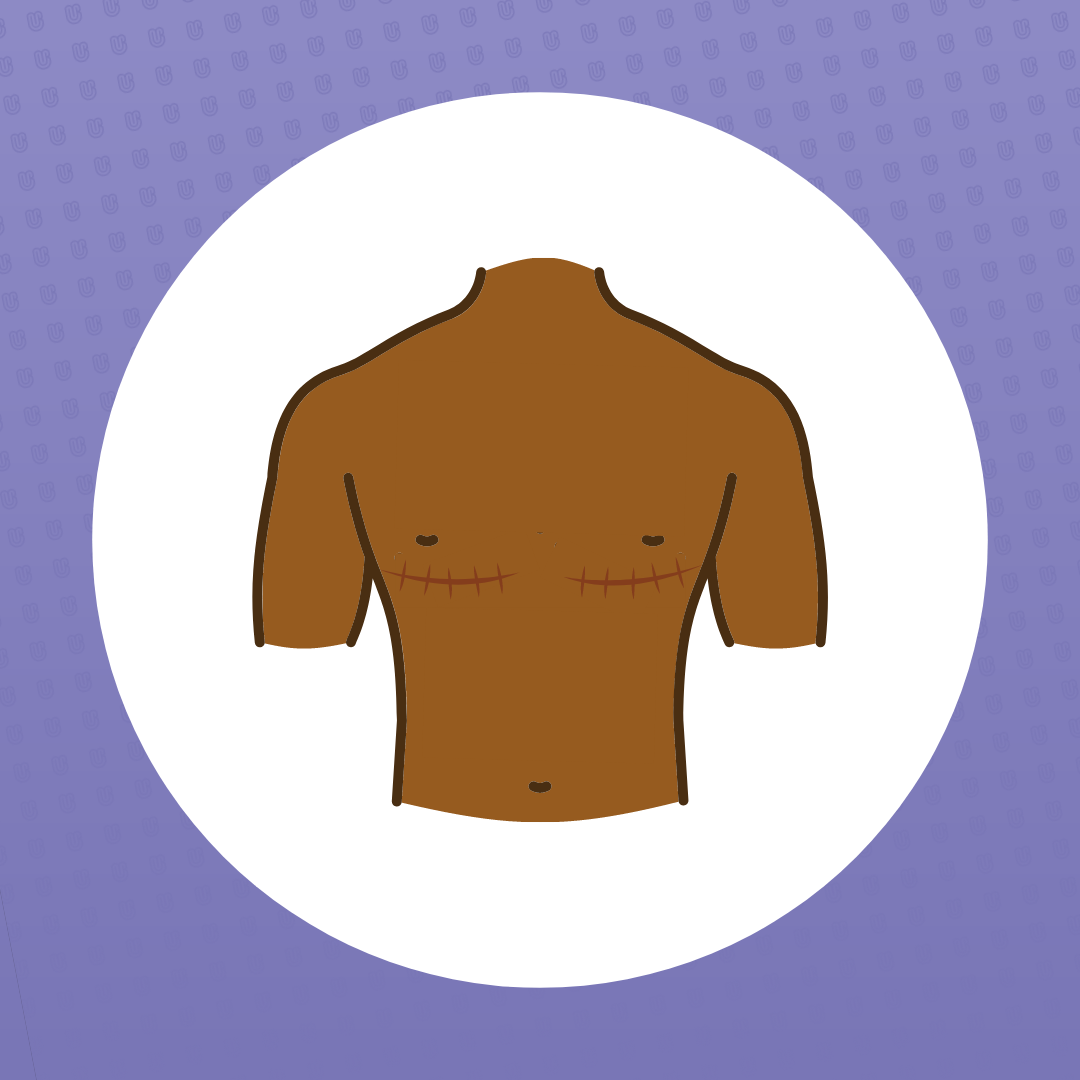For many transgender men and masculine-presenting AFAB (assigned female at birth) individuals, the chest is a common source of gender dysphoria.
Some men and non-binary individuals bind their chests to make themselves appear “flatter” and more “masculine” to alleviate this dysphoria, but binding continuously and long-term can cause a whole spate of side effects, from skin infections to breathing problems.
Another option is top surgery, a procedure done by a plastic surgeon to alter the size, shape, and overall appearance of one’s chest. While not all trans men and transmasculine people feel the need to get top surgery, for others, it is an essential step towards gender affirmation.
Here, we’ll discuss everything you need to know about female-to-male (FTM) or female-to-non-binary (FTN) top surgery, from the most common types of procedures to tips for recovery.
What Is Top Surgery?
FTN or FTM top surgery (also called masculinizing chest reconstruction) is a gender-affirming surgery that involves reducing or removing breast tissue and repositioning the nipples to give patients the appearance of a more "masculine" or male chest.
Top surgery is normally an outpatient procedure that can take as little as 1.5 hours to as long as 4 hours. The recovery period, however, may take between two and eight weeks.
There are three common types of top surgery procedures. While the technique you get is partially up to you and your surgeon, factors like your breast size, nipple placement, and skin elasticity may limit your options.
Double Incision Top Surgery (With Nipple Grafts)
Also called a bilateral mastectomy, this type of top surgery is usually the best option for patients with large breasts. With a bilateral mastectomy, your surgeon creates two horizontal incisions on the bottom border of your breasts. In some cases, especially for those with a lot of breast and chest wall tissues, surgeons may recommend lateral chest wall liposuction.
Do note that this procedure results in large, visible scarring. With double incision top surgery, scars are often made to fade in such a way that they appear as pectoral muscle “shadowing” that is typical in a male chest. However, neither you nor your surgeon will be able to do much to control how your scars heal.
Oftentimes, your surgeon will also remove your nipples so they can be repositioned and grafted in place. Nipple grafts are done to give the appearance of a more "male" chest. As a result, most people who undergo this procedure report reduced or loss of nipple sensation.
Periareolar Top Surgery
If you have a smaller chest (usually a size A or B cup) and good skin elasticity, your surgeon may deem you eligible for a periareolar or peri or “donut” top surgery. With this surgery, your surgeon will create an incision around the border of your areola, and a larger, circular incision on the skin around it. The breast tissues are then removed from the small opening.
Once this – and additional chest contouring or chest reconstruction – is done, your surgeon will close up the area, reducing your areola and nipple size as well.
With this type of chest surgery, most patients do not lose nipple sensation as surgeons usually leave the nipple stalk intact. Another upside to this procedure is less visible scarring. However, there is a 40 to 60 percent chance that you may require revisions, depending on how your chest heals.
Keyhole Top Surgery
This is a rarer type of surgery that is only done on patients with very little breast tissue and tight chest skin. With this kind of surgery, a small incision is made along the bottom part of the areola. From there, surgeons remove the breast tissues, sometimes with the help of liposuction.
But because this surgery is only possible with people who are mostly flat-chested, it could be harder to find a surgeon that does the procedure. Another downside to this option is that it doesn’t give the patient the option to reposition their nipples.
Preparing For Top Surgery
Prior to surgery, you’ll have to make a few lifestyle changes and mental preparations. You’ll also have to sit down with your surgeon to discuss important details about your personal and family medical history.
Here are 5 things you should do before your surgery:
Discuss Assessment And Funding With Your Primary Care Provider
You can typically get health insurance coverage for most types of gender-affirming surgeries in Canada. However, each province has its own set of rules and restrictions regarding eligibility, assessment requirements, counselling requirements, travel assistance, and surgery costs.
The criteria for gender-affirming surgeries usually includes:
- The capacity to consent to the medical procedure
- Being of legal age
- Persistent gender dysphoria
- Meeting the medical and mental health conditions
When you go in for a consultation or assessment, you will be asked about:
- Your gender identity
- Your personal and family medical history, including vaccines, pre-existing conditions, surgery history, any medications you’re currently on, any allergies, etc.
- Your mental health (you may be recommended counselling if deemed necessary by the assessor)
- The techniques you prefer
- Your expectations on the outcome of the surgery
- Your financial situation and how much of the surgery cost you can afford
- Your support system and the attitudes of your family, friends, schoolmates, and people you work with towards your journey
- Your plan for aftercare
Candidates can expect to wait up to 6 months for their assessment to be completed.
During your assessment, you’ll also learn about the potential risks involved with top surgery, such as potential negative reactions to anesthesia, infections, blood clotting, severe scarring, loss of or reduced nipple sensation, dog ears (excess skin and fat that pucker out the edge of the incision line) and the possible need for revisions.
On the flip side, when you meet with your surgeon, come ready with all the questions you have about the surgery. Surgeons are happy to entertain any breast augmentation-related question their patients have, so don't be shy!
Look Into Your Family History Of Breast Cancer
BRCA1 and BRCA2 are both useful genes that AFABs inherit from their parents. However, certain mutations of these genes have been found to lead to an increased risk of breast cancer and ovarian cancer – sometimes up to 80 percent. There is a simple blood test that can determine whether individuals have a BRCA1 or BRCA2 mutation, and more and more doctors are recommending this before a top surgery. Most health insurance providers cover this test.
While being BRCA positive doesn’t change your eligibility for surgery, it’s important to know if you have these mutations. If you are positive, your surgeon will be more mindful about removing “at-risk” breast tissues during the mastectomy to nip cancer in the bud.
Not all surgeons will ask their patients this question before surgery, so it's best to be proactive about this for your own health.
Avoid Alcohol And Cigarettes
Avoid drinking alcoholic beverages at least a week before your surgery and in the weeks after surgery as you recover. Both alcohol and anesthesia affect breathing and heart rate – putting too much strain on these functions can lead to serious complications during surgery.
Meanwhile, if you are a smoker, you should stop smoking at least three weeks prior. This is because smoking can lead to breathing problems during or after surgery, increase your risk for pneumonia, and slow down healing. The last part is especially important, as you don’t want your incisions to become infected later on.
Make Your Home And Wardrobe More Comfortable For Recovery
After top surgery, you’re advised not to lift your arms over 90 degrees above your head or away from your body for the first four weeks. This is to ensure that your scars heal well and you don’t stretch the skin around them too much.
If you live alone or consider yourself an independent person, this could pose a lot of challenges in your day-to-day life – from getting dressed to reaching for things in your kitchen cupboards. Most trans men deal with this by stocking up on button-down shirts and zip-up hoodies to make dressing easier. Other remedies include repositioning essential items and attaching rope pulls on heavy doors.
Another challenge you’ll face is showering. For the first six to seven days, you’ll have two surgical drains attached to the sides of your chest, along with dressings over the incision line and your nipples.
You won’t be allowed to take these off, so wetting your upper body is off the table for at least a week. Stock up on wet wipes and dry shampoo to stay clean and fresh while you wait for your first post-op appointment.
Surgeons also recommend their patients wear a compression vest or binder 24/7 for the first month. The vest helps keep fluid from building up and makes your skin stick as close to your chest wall as possible.
Finally, make sure you have a lot of pillows. Most surgeons advise people to sleep upright or at a 45-degree angle for the first few days after top surgery, so sleeping could get uncomfortable. Make sure you have a neck pillow and big, soft body pillows to keep you comfortable. Better yet, borrow a cushy recliner for maximum comfort!
Other essential items (and stuff you should factor into your top surgery costs) include:
- Ice packs to reduce pain, bruising and swelling
- Scar treatment creams or gels. Most surgeons recommend something like Biocorneum. You can start applying this after about eight weeks post-op. You can also undergo Mechanical Scar Reduction Therapy if your scars are thick.
- Fruits and vegetables that you can blend into a smoothie for when you’re too tired or in too much pain to cook a meal
- A back scratcher for those hard-to-reach itches
- A straw to make drinking easier when bending is still too painful
- A padded lap tray so you can eat in bed comfortably
Be Ready For Postoperative Depression
It may be strange to think that you might get depressed after your operation. After all, top surgery gets you one step closer to feeling at home in your own body.
However, all kinds of surgery can elicit a rollercoaster of emotions. Think about it – after an operation, you’re confined to your bed for weeks, you’re in a lot of pain, and you have to rely on other people for help. It's hard to be patient all the time. Plus, in the first few weeks after chest reconstruction, you won’t be able to see your new male chest anyway, as it will be covered in bandages and tape.
Postoperative depression doesn’t affect everyone, but it’s best to be prepared for it just in case. Here are a few tips for coping:
- Surround yourself with friends and family who are supportive of your journey. Whether it’s someone to help empty your drains, clean up at home, or just to laugh with during a tough time, a loved one’s presence and warmth can make all the difference.
- Have a therapist you can confide in. This is especially helpful if you’re already prone to depression and anxiety. A professional can help guide you through the healing process with healthy ways to cope.
- Be kinder to yourself. This is easier said than done, but it bears repeating. Often, we’re our own worst critics. Be more patient and forgiving towards yourself and your body. Remember, you’ve just gone through a major life change – that in itself is something you can be proud of.
FTN And FTM Top Surgery Recovery Timeline
So what does recovering from top surgery actually entail? Here’s a rough timeline, including when you can expect to make doctor's appointments. Remember, one patient will recover at a different pace than another patient, and wound healing looks different from patient to patient.
One to Two Days After Surgery
The first 48 hours will be the hardest – remind yourself to be patient! As you wake up from surgery and the anesthesia wears off, you’ll experience muscle pain, nausea, vomiting, and tenderness around the chest. Most people report itching and swelling on their chests around this time as well.
As mentioned, you’ll have drains, bandages, and a compression vest right after surgery. You won’t be allowed to remove these until your first post-op check-up about a week later. You also won’t be allowed to shower from the waist up, so make sure to have plenty of wet wipes and dry shampoo on hand.
One to Two Weeks After Surgery
During your first postoperative consultation, you’ll have your drains and areola dressings removed. This may be an emotional moment for you, as it will be the first time you’ll be seeing your bare chest. You might want to have a close and trusted ally with you during this appointment.
After the consultation, you’ll be allowed to shower. Depending on your surgery, you’ll likely have to apply dressings on your scars and nipples. You’ll also have to keep your vest on 24/7 until the second appointment, which happens about three weeks to a month after surgery.
Three Weeks to One Month After Top Surgery
Around this time, you may be allowed to return to work, especially if your job doesn’t require a lot of physical activity. You can also do light exercises and lift your hands above your shoulders gradually.
Your scars will probably also have healed to the point where itching and swelling are down to a minimum. At this point, you’ll be asked to apply a scar treatment gel or cream to help with healing.
Two Months After Top Surgery
Generally, you can go back to your usual activities two months after top surgery, including exercising and doing heavy lifting. You will have to continue scar care, as well as apply sunscreen if you ever go out without a shirt.
For many trans men and transmasculine folks out there, getting top surgery is a life-changing decision. However, because it’s such a big and permanent change, it requires a lot of careful planning and preparation.
Whether you’re ready to take the plunge or are looking to start small with a chest binder, you can visit our website product page to get more information about the various gender-affirming steps and procedures you can take.




Leave a comment
This site is protected by hCaptcha and the hCaptcha Privacy Policy and Terms of Service apply.